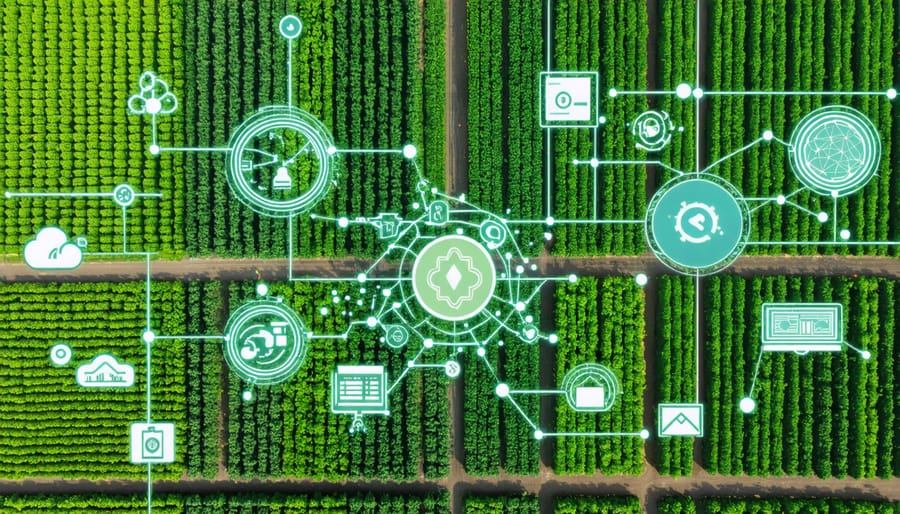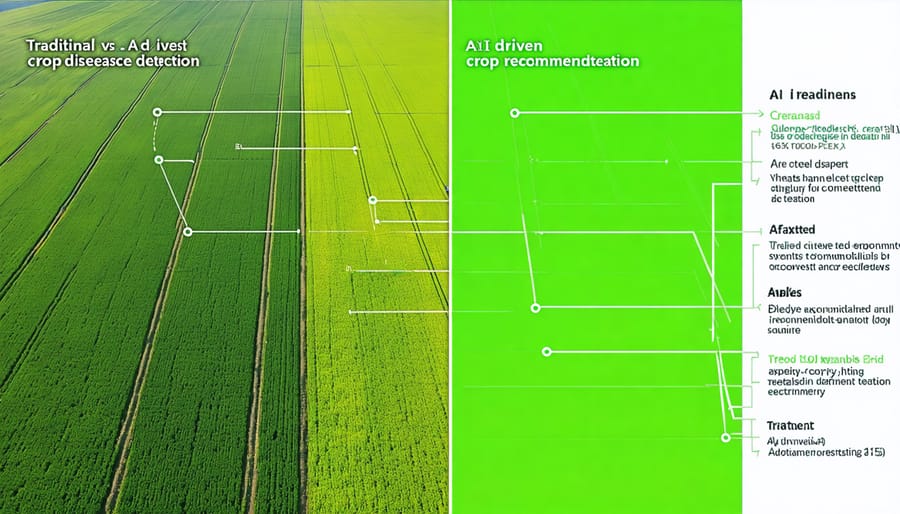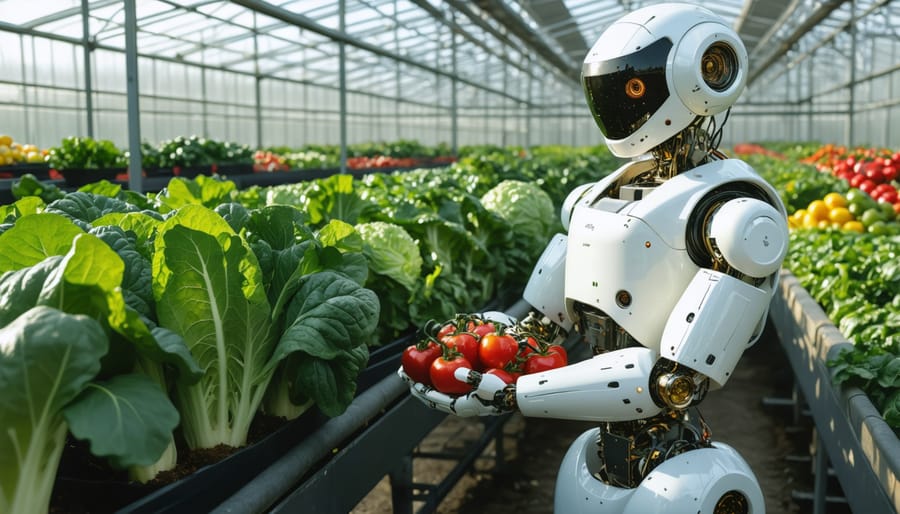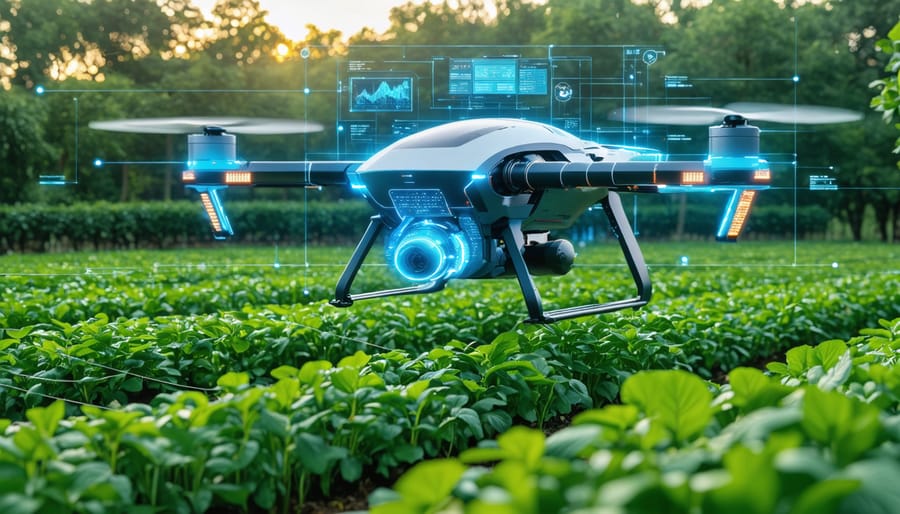Revolutionizing modern farming through sustainable agriculture innovations has become critical as we face unprecedented environmental challenges and growing food demands. Smart sensors now monitor soil health in real-time, reducing water usage by up to 30% while maximizing crop yields. Precision farming technologies, powered by artificial intelligence, analyze vast datasets to optimize resource allocation, minimize waste, and predict weather patterns with remarkable accuracy.
These innovations aren’t just transforming large-scale operations – they’re democratizing sustainable farming practices for agricultural communities worldwide. From vertical farming systems that grow food with 95% less water to regenerative techniques that sequester carbon while improving soil fertility, technology is enabling farmers to produce more while treading lighter on the planet.
As climate change intensifies and global population surges, these agricultural breakthroughs offer hope for a future where abundance and environmental stewardship coexist. By harnessing the power of data, automation, and biological innovation, we’re witnessing the emergence of a more resilient, efficient, and sustainable food system that could help feed 10 billion people by 2050 while protecting our planet’s vital resources.

Smart Sensors and IoT: The New Eyes of Sustainable Farming
Precision Irrigation Systems
Precision irrigation systems represent a groundbreaking fusion of AI technology and water management in modern agriculture. These smart systems utilize a network of soil moisture sensors, weather monitors, and crop health indicators to deliver water exactly when and where plants need it most.
At the heart of these systems, AI algorithms process real-time data from multiple sources, including soil moisture levels, local weather forecasts, and historical irrigation patterns. Smart sensors embedded throughout fields continuously monitor soil conditions, while machine learning models analyze this data to predict optimal watering schedules for different crop zones.
The impact on water conservation is remarkable. Farmers using AI-powered irrigation systems typically report 30-50% reduction in water usage while maintaining or even improving crop yields. For example, a vineyard in California implemented precision irrigation and reduced their water consumption by 40% in just one growing season.
These systems also prevent over-watering, which can lead to soil erosion and nutrient leaching. The AI monitors root zone moisture levels and adjusts irrigation in real-time, ensuring plants receive precisely the right amount of water for optimal growth. Weather predictions are factored in automatically – if rain is forecasted, the system adjusts accordingly to prevent waste.
The technology continues to evolve, with newer systems incorporating drone imagery and satellite data to create even more accurate irrigation maps. This data-driven approach not only conserves water but also promotes healthier crop development and reduces the environmental impact of agricultural operations.
Soil Health Monitoring
Modern agriculture has witnessed a revolutionary transformation through AI-driven soil health monitoring systems. These intelligent solutions combine sensor technology, machine learning algorithms, and real-time data analysis to provide farmers with unprecedented insights into their soil’s condition.
Advanced sensors embedded in the soil continuously measure crucial parameters including moisture levels, pH balance, nitrogen content, and organic matter composition. This data is transmitted to cloud-based platforms where AI algorithms process and analyze the information, creating detailed soil health maps and predictive models.
What makes these systems particularly valuable is their ability to detect subtle changes in soil conditions before they become visible problems. For instance, AI can identify early signs of nutrient deficiency or pH imbalances, allowing farmers to take corrective action promptly. The technology also helps optimize fertilizer use by providing precise recommendations based on actual soil needs rather than general guidelines.
Real-time monitoring has proven particularly effective in water conservation. Smart irrigation systems, guided by AI-analyzed soil moisture data, can reduce water usage by up to 30% while maintaining optimal growing conditions. These systems also help prevent over-fertilization, which not only saves costs but also protects groundwater from excess nutrient runoff.
Farmers can access all this information through user-friendly mobile apps, receiving actionable insights and alerts directly on their smartphones. This democratization of advanced soil science has made sustainable farming practices more accessible to agricultural operations of all sizes.
AI-Powered Crop Management
Predictive Analytics for Crop Planning
Modern farming faces unprecedented challenges from climate change and resource constraints, but machine learning technologies are revolutionizing how we approach crop planning. By analyzing vast amounts of data from soil sensors, weather patterns, and historical yield records, AI-powered systems can now predict optimal planting times and crop rotation schedules with remarkable accuracy.
These predictive systems consider multiple variables simultaneously – from soil moisture levels and nutrient content to local weather forecasts and market demands. For example, a farmer in the Midwest can receive AI-generated recommendations for when to plant soybeans based on soil temperature predictions, expected rainfall patterns, and frost risk assessments.
The technology goes beyond simple scheduling. AI models can suggest ideal crop rotation sequences that maximize soil health while minimizing pest and disease risks. If data indicates declining soil nitrogen levels, the system might recommend planting legumes in the next rotation to naturally replenish nutrients.
What makes these systems particularly valuable is their ability to learn and adapt. Each growing season provides new data that helps refine future predictions. A farm that implements AI-driven crop planning typically sees a 15-25% increase in yield efficiency while reducing resource waste.
The environmental benefits are significant too. By optimizing planting schedules and crop combinations, farmers can reduce water usage, minimize fertilizer application, and maintain better soil health. This data-driven approach helps create more resilient and sustainable agricultural systems that can better withstand climate variations while producing consistent yields.
Looking ahead, these predictive systems will become even more sophisticated, incorporating real-time satellite imagery and advanced climate models to provide increasingly accurate recommendations for sustainable farming practices.
Disease and Pest Management
Modern agriculture has witnessed a revolutionary shift in disease and pest management through the integration of AI-powered early warning systems. These innovative solutions combine data from multiple sources, including satellite imagery, ground sensors, and weather stations, to detect potential threats before they become widespread problems.
Machine learning algorithms analyze historical pest patterns, weather conditions, and crop health indicators to predict potential outbreaks with remarkable accuracy. Farmers receive real-time alerts on their smartphones or tablets, allowing them to take preventive action precisely when and where needed, rather than applying blanket treatments across entire fields.
Computer vision technology, coupled with drone surveillance, can identify early signs of disease by analyzing leaf coloration and plant structure changes. This early detection system enables farmers to implement targeted interventions, significantly reducing the need for chemical pesticides and helping preserve beneficial insects and soil microorganisms.
Smart spraying systems, guided by AI, can distinguish between crops and weeds, applying treatments only where necessary. This precision approach has led to a 90% reduction in pesticide use on some farms while maintaining or improving crop yields. Additionally, AI systems continuously learn from new data, improving their accuracy and adapting to changing environmental conditions and pest behaviors.
These technological advances not only protect crops more effectively but also support the broader goals of sustainable agriculture by minimizing chemical inputs, reducing environmental impact, and preserving biodiversity. As these systems become more sophisticated and accessible, they’re helping farmers transition from reactive to proactive pest management strategies, marking a significant step forward in sustainable farming practices.

Automated Farming Systems
Smart Harvesting Robots
Smart harvesting robots are revolutionizing agricultural practices by combining artificial intelligence with precision engineering to automate one of farming’s most labor-intensive tasks. These autonomous machines use advanced computer vision and machine learning algorithms to identify ripe produce, determine optimal picking patterns, and harvest crops with remarkable accuracy.
Equipped with sophisticated sensors and cameras, these robots can work around the clock, significantly reducing labor costs while maintaining consistent quality. For example, strawberry-picking robots can now detect ripeness with 95% accuracy and handle delicate fruits without causing damage. Similar systems have been developed for tomatoes, apples, and other high-value crops, as demonstrated in numerous real-world farming success stories.
The impact on labor efficiency is substantial. A single harvesting robot can replace the work of 8-10 human pickers while operating continuously in various weather conditions. This technology particularly benefits regions facing agricultural labor shortages and helps farmers maintain productivity during peak harvesting seasons.
Beyond efficiency, these robots contribute to sustainability by reducing food waste through precise harvesting. They can collect data about crop health and yield patterns, helping farmers make more informed decisions about future planting and resource allocation. This integration of AI-powered harvesting with data analytics represents a significant step toward more sustainable and efficient farming practices.

Drone Technology in Agriculture
Drones equipped with advanced AI systems are revolutionizing agricultural practices, offering farmers unprecedented insights into their crops and enabling precision farming at scale. These aerial platforms combine high-resolution cameras, multispectral sensors, and machine learning algorithms to provide real-time data about crop health, soil conditions, and potential issues.
Modern agricultural drones can scan vast fields in minutes, creating detailed maps that highlight variations in crop growth, pest infestations, and irrigation needs. The AI systems process this data to identify early signs of crop disease, nutrient deficiencies, or water stress before they become visible to the human eye. This early detection capability allows farmers to take targeted action, reducing the need for blanket application of pesticides and fertilizers.
One of the most impactful applications is variable-rate application, where drones use AI-generated maps to apply precise amounts of inputs exactly where needed. This smart approach not only reduces chemical usage but also minimizes environmental impact while maintaining crop yields.
Thermal imaging capabilities enable drones to assess crop moisture levels and identify irrigation issues, helping farmers optimize water usage. Some advanced models even employ computer vision to count plants, estimate yield potential, and track crop development throughout the growing season.
The integration of drone technology with farm management systems creates a powerful tool for data-driven decision-making, enabling farmers to practice more sustainable and efficient agriculture while reducing operational costs and environmental impact.
The Future of AI in Sustainable Farming
Artificial Intelligence is poised to revolutionize sustainable agriculture in ways we’re only beginning to imagine. As we look toward the future, AI’s role in implementing smart sustainable farming practices will become increasingly crucial in addressing global food security challenges while minimizing environmental impact.
One of the most promising developments is the integration of advanced machine learning algorithms with IoT sensors to create self-adjusting farming systems. These systems will be capable of making real-time decisions about irrigation, fertilization, and pest control without human intervention, dramatically reducing resource waste and environmental impact.
Predictive analytics is set to become more sophisticated, enabling farmers to anticipate crop diseases and weather-related challenges weeks or even months in advance. This technological leap will allow for proactive rather than reactive farming approaches, potentially saving entire harvests from devastation while minimizing the use of protective chemicals.
Drone technology combined with AI will evolve to perform increasingly complex tasks, from targeted pollination to precise crop monitoring. Future drones will likely be equipped with advanced sensors capable of detecting subtle changes in plant health, soil composition, and water stress levels with unprecedented accuracy.
Perhaps most exciting is the development of AI-powered agricultural robots that can work alongside human farmers. These robots will become more sophisticated in their ability to handle delicate tasks like selective harvesting and precision weeding, reducing labor costs while increasing efficiency.
The future also holds promise for AI-driven genetic research, helping develop more resilient crop varieties that can thrive in challenging conditions while requiring fewer resources. This advancement could be key to adapting agriculture to climate change while maintaining sustainable practices.
As these technologies mature, they’ll become more accessible to smaller farms, democratizing sustainable agriculture and helping create a more resilient global food system. The key to success will lie in balancing technological advancement with ecological responsibility, ensuring that innovation serves both productivity and sustainability goals.
The convergence of AI and sustainable agriculture represents a pivotal moment in our journey toward a more resilient and environmentally conscious food system. Through the innovations we’ve explored, from precision farming to predictive analytics, it’s clear that technology is not just enhancing agricultural efficiency but fundamentally transforming how we approach food production while protecting our planet’s resources.
These advancements are already showing promising results: reduced water consumption, decreased pesticide use, improved soil health, and enhanced crop yields. Farmers who have embraced these technologies report significant improvements in both productivity and sustainability metrics, proving that environmental stewardship and profitable farming can go hand in hand.
However, the true potential of AI in sustainable agriculture can only be realized through widespread adoption and continued innovation. As we face mounting challenges from climate change and growing food demand, the agricultural sector must embrace these technological solutions. This calls for collaboration between farmers, technologists, researchers, and policymakers to create an ecosystem that supports the implementation of sustainable agricultural practices.
The future of farming lies in our ability to harness AI’s capabilities while maintaining focus on sustainability goals. Whether you’re a farmer, agricultural professional, or technology innovator, now is the time to explore and implement these solutions. By doing so, we can work together to build a more sustainable and food-secure future for generations to come.

